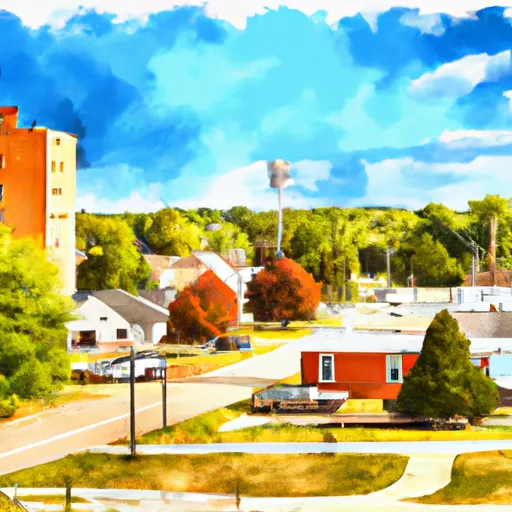-
 Snoflo Premium
Snoflo Premium
Get unlimited access to all our content
With no Ad interruptions! - Start Your Free Trial Login with existing account
Newberry
Eden Index
Climate
5.9
•
Recreation
3.0
•
Community
•
Safeguard
3.4/10

Newberry, Michigan, located in the Upper Peninsula, experiences a cool-temperate climate with long, snowy winters and mild summers. The town is surrounded by beautiful forests, lakes, and rivers, making it a haven for outdoor enthusiasts. The hydrology constituents of Newberry include several pristine lakes, such as the popular Tahquamenon Falls and Muskallonge Lake. These bodies of water offer opportunities for boating, fishing, and swimming. Additionally, the area is known for its extensive trail system, including the famous North Country Trail and the Tahquamenon Falls State Park trails. These trails attract hikers, bikers, and snowmobilers, providing ample opportunities for outdoor recreation throughout the year. Newberry truly offers a picturesque setting for nature lovers to explore and enjoy.
What is the Eden Index?
The Snoflo Eden Index serves as a comprehensive rating system for regions, evaluating their desirability through a holistic assessment of climate health, outdoor recreation opportunities, and natural disaster risk, acknowledging the profound impact of these factors on livability and well-being.
Climate Health Indicator (CHI): 5.9
Newberry receives approximately
807mm of rain per year,
with humidity levels near 83%
and air temperatures averaging around
6°C.
Newberry has a plant hardyness factor of
5, meaning
plants and agriculture in this region thrive during a short period during spring and early summer. Most
plants will die off during the colder winter months.
By considering the ideal temperature range, reliable water supplies, clean air, and stable seasonal rain or snowpacks, the Climate Health Indicator (CHI) underscores the significance of a healthy climate as the foundation for quality living.
A healthy climate is paramount for ensuring a high quality of life and livability in a region, fostering both physical well-being and environmental harmony. This can be characterized by ideal temperatures, reliable access to water supplies, clean air, and consistent seasonal rain or snowpacks.
Weather Forecast
Streamflow Conditions
Southeastern Lake Superior
Area Rivers
Southeastern Lake Superior
Snowpack Depths
Southeastern Lake Superior
Reservoir Storage Capacity
Southeastern Lake Superior
Groundwater Levels
Recreational Opportunity Index (ROI): 3.0
The Recreational Opportunity Index (ROI) recognizes the value of outdoor recreational options, such as parks, hiking trails, camping sites, and fishing spots, while acknowledging that climate plays a pivotal role in ensuring the comfort and consistency of these experiences.
Access to outdoor recreational opportunities, encompassing activities such as parks, hiking, camping, and fishing, is crucial for overall well-being, and the climate plays a pivotal role in enabling and enhancing these experiences, ensuring that individuals can engage in nature-based activities comfortably and consistently.
Camping Areas
| Campground | Campsites | Reservations | Toilets | Showers | Elevation |
|---|---|---|---|---|---|
| Blind Sucker 2 - State Forest | 32 | 635 ft | |||
| Woodlily - White Lake Provincial Park | 66 | 1,137 ft | |||
| Blind Sucker 1 - State Forest | 13 | 634 ft | |||
| Culhane Lake - State Forest | 22 | 635 ft | |||
| Lake Superior - State Forest | 18 | 627 ft | |||
| Sundew - White Lake Provincial Park | 36 | 1,090 ft | |||
| Mouth of Two Hearted River - State Forest | 39 | 615 ft | |||
| Moccasin Flower - White Lake Provincial Park | 85 | 1,124 ft | |||
| Bodi Lake - State Forest | 20 | 650 ft | |||
| Muskallonge Lake State Park | 170 | 644 ft |
Nearby Ski Areas
Catastrophe Safeguard Index (CSI):
The Catastrophe Safeguard Index (CSI) recognizes that natural disaster risk, encompassing floods, fires, hurricanes, and tornadoes, can drastically affect safety and the overall appeal of an area.
The level of natural disaster risk in a region significantly affects safety and the overall livability, with climate change amplifying these risks by potentially increasing the frequency and intensity of events like floods, fires, hurricanes, and tornadoes, thereby posing substantial challenges to community resilience and well-being.
Community Resilience Indicator (CRI):
The Community Resilience Indicator (CRI) recognizes that education, healthcare, and socioeconomics are crucial to the well-being of a region. The CRI acknowledges the profound impact of these elements on residents' overall quality of life. By evaluating educational resources, healthcare accessibility, and economic inclusivity, the index captures the essential aspects that contribute to a thriving community, fostering resident satisfaction, equity, and social cohesion.

